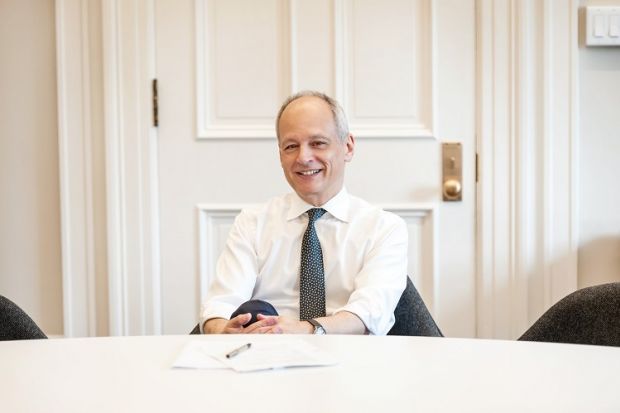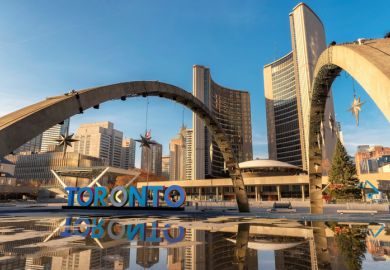How should a university interact with people and places beyond its national borders? That is the question that geographer Meric Gertler, who has spent his entire career at one institution, took on when he ascended to the role of president of the University of Toronto in 2013.
In the ninth in our Talking Leadership series, he tells Times Higher Education how he developed the strategy that he hoped would shore up Toronto’s footing on the global stage, his views on brain drain and why he’s remained enthralled by the city of Toronto for almost four decades.
Hitting reset
When Gertler became president of the institution he first joined in 1983, Toronto had no international strategy; its links with the rest of the world had grown organically over its 200 years of existence. About half the faculty and a quarter of students were from outside Canada, and yet “we had never really deliberately focused on internationalising before, and whatever we had done had been kind of almost by accident”, Gertler says.
The university’s ability to keep its perch at the top of the global rankings (Toronto sits at joint 18th in the latest THE World University Rankings), to entice international students and to solve global problems via international collaborations meant that for the calm and composed Gertler, “the international realm had become far too important to the success of the university to do it by accident, or to do it without a deliberate strategy”.
“It made sense for us to hit the reset button,” says Gertler. If he was daunted by the task, he masks it well.
The first pit stop on his journey to “double down on internationalising” was a tour of departments, presenting his ideas on going global and listening to his staff. Next, he appointed a vice-president with a new brief – international – because the task was “far too significant strategically for us to manage it off the side of someone’s desk”.
The new vice-president was dispatched on a university tour of their own, and a strategy began taking shape. Using seven metrics – international student recruitment, outbound student mobility, academic partnerships, industrial partnerships, entrepreneurship, fundraising and reputation – they drew up a target list of countries and institutions.
Spat with the Saudis
One objective was to increase the number of countries their students were flying in from. In 2018, the exposure that comes with relying on too few regions for incoming students was laid bare: a tweet from a Canadian politician criticising Saudi Arabia’s treatment of women led to the largest country in the Middle East recalling its students.
“It was a relatively small number [of students], but it had quite an impact in certain faculties, such as our Faculty of Medicine,” Gertler says. “That was a timely reminder that as you succeed in internationalising your enrolment, you do have to be attentive to the risks that come with it.”
Now they have identified new countries to tap up, such as Mexico.
“There are a lot of middle-class families that send their kids to English-language high schools, with the goal of undertaking university studies in an English-speaking country. Traditionally that’s been the US and, to some extent, the UK. But given that we’re on the same continent, we thought it’s crazy not to be recruiting more Mexican students to a place like Toronto.”
Brain drain
There is deep antipathy in some quarters to the recruitment of top students from lower- and middle-income countries. In 2020, Adam Habib, then leader of the University of the Witwatersrand in South Africa and now director at SOAS University of London, said universities’ efforts to recruit students from developing countries had “weakened” the progress of those students’ home nations. Many contend that institutions in richer nations should work to fortify those in poorer countries instead of siphoning off their top talent.
“I don’t think the construct of the brain drain is really all that useful in this conversation,” Gertler says. He prefers the notion of the “brain chain”, citing research showing that students from India, Taiwan, South Korea and Israel who studied in Silicon Valley founded start-ups that then created links back to their home countries, “which actually is quite an important phenomenon that has helped to drive the advancement of those countries and their own kind of innovation economies”.
He points out that Toronto has been working in partnership to strengthen Addis Ababa University in Ethiopia for 20 years, building its capacity in medicine.
“Ninety-five per cent of the students involved in that programme, or the faculty involved, have stayed in country after their participation in the partnership with the University of Toronto. So it really has got a demonstrated track record of building capacity locally that stays in the home country. And I think that is extremely important,” says Gertler.
Toronto’s new strategy includes expanding this type of work in Africa, which is “a really exciting new element…leading us in a different direction”, he says.
“It’s not about collaborating with the usual suspects – the UK, or Australia, or the US or other English-speaking countries – it’s about taking advantage of different kinds of learning opportunities and exciting research opportunities.”
As well as much needed cash, international students bring the benefit of different perspectives for all to learn from. But how do you counter the human propensity towards familiarity and ensure the intermingling of students across nationalities?
Toronto has developed “first-year learning communities”, in which about a dozen students from different countries are convened into a support network, with a faculty member to support them. “We compose these groups in a way to accentuate cultural diversity as much as possible,” says Gertler.
Pushback
Not all his academics welcomed the new strategy with open arms. Those with pre-existing relationships with peers in regions not on the target list were uneasy. “The sorts of colleagues I work with at this university halfway around the world or in this country are less important?” they put to him.
When asked if there is anything Gertler would do differently if he were to start the process again, he is reluctant to draw out criticism, but says there is something he would have started earlier. He has panels of experts on different countries, called “presidential international councils”. Made up of academics who specialise in certain regions as well as those who grew up or lived in them, they offer strategic advice and are “proving to be really valuable”.

Pause on travel
On a pre-pandemic student recruitment trip to China, Gertler promised high schoolers an international experience if they crossed the Pacific to come to Toronto.
The pandemic pressed pause on the usual internships and trips abroad, of course, but one aspect was able to continue. Online “global classrooms” for undergraduates have been a successful introduction to internationalisation for Toronto’s students.
Faculty at Toronto team up with those at another university to design and teach a course delivered online to a class of students from both institutions, and students work in mixed teams.
“It’s one of the best ways that we’ve been able to internationalise the experience for undergraduates during a time when they cannot travel,” says Gertler. “And this was really important because we had created all of this demand from our undergraduates, we had encouraged them to seek an international experience.”
Globalised higher education
In 2018, Gertler wrote a paper warning of the rise of nationalism and parochial thinking, and suggesting what universities can do to counter it. Does he stand by those sentiments today? “We see some interesting and somewhat contradictory trends,” he says. “On the one hand, the kind of collaboration globally that led to the production of vaccines against Covid-19 in record time is unprecedented. That’s been a big win for open, collaborative science.
“The flip side of that is less appealing, and kind of worrisome: the phenomenon of vaccine nationalism. The fact that when it comes to the distribution of vaccines, the geography is much more uneven, that countries have tended to want to emphasise self-sufficiency above all else when it comes to protective personal equipment and vaccine supply.”
One city
Gertler is somewhat unusual for a university leader in that he has spent his entire career at one institution. He sees the downsides and benefits to this.
“If you recruit from outside, you might benefit from fresh perspectives, and new ideas from other contexts and environments that could be beneficial to Toronto, and that benefit is real,” he says.
But the University of Toronto is “a big, complicated place, it’s a very complex environment in which to operate effectively. I’ve been here for 35 years or more, and I’m still learning new things about the place…its structure isn’t necessarily all that rational…It may take a newcomer multiple years to really be effective at operating in this environment.”
Doesn’t a comparative urban geographer have an urge to live elsewhere, to experience the bustle of New York or London perhaps? Gertler has had brief forays to other regions for research purposes, and he believes most academics “are globalists at heart”.
“When I started out, I expected that I would probably stay at Toronto for a few years, perhaps get tenure, and then think about moving on,” he says. But his university colleagues kept him intellectually stimulated and the city of Toronto became ever more diverse and interesting.
Perhaps he’ll leave the University of Toronto for pastures new when he steps down as president? “I have no plans to,” Gertler says, adding that he will stay and pursue new avenues of enquiry. “My work as president has opened up lots of interesting research questions for me.”
Quick facts
Born: Edmonton, Canada in 1955
Academic qualifications: BA in geography from McMaster University; master of city planning from the University of California, Berkeley; PhD from Harvard University
Lives with: His wife and cat
Academic hero: British economist Joan Robinson. “She challenged the orthodoxy of mainstream economics and came up against some very powerful figures.”
This is part of our “Talking leadership” series of 50 interviews over 50 weeks with the people running the world’s top universities about how they solve common strategic issues and implement change. Follow the series here.
View the THE list of the world’s most international universities 2022
Register to continue
Why register?
- Registration is free and only takes a moment
- Once registered, you can read 3 articles a month
- Sign up for our newsletter
Subscribe
Or subscribe for unlimited access to:
- Unlimited access to news, views, insights & reviews
- Digital editions
- Digital access to THE’s university and college rankings analysis
Already registered or a current subscriber? Login







